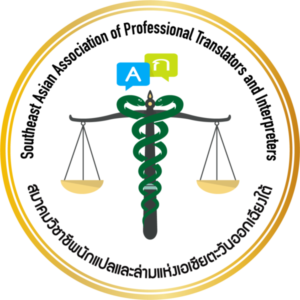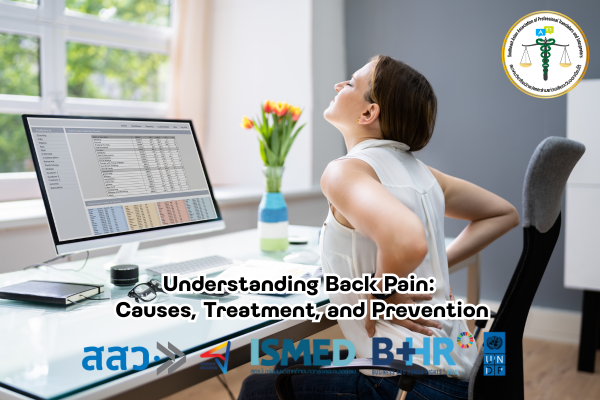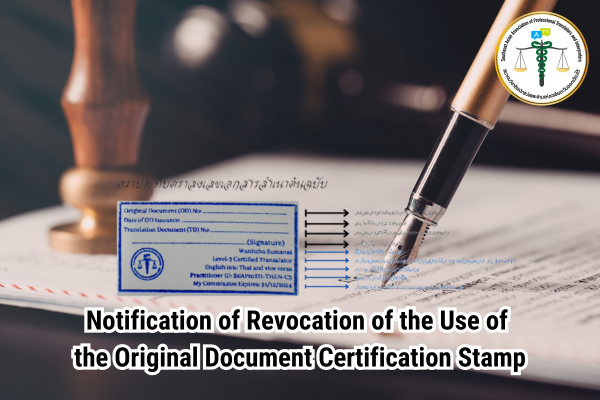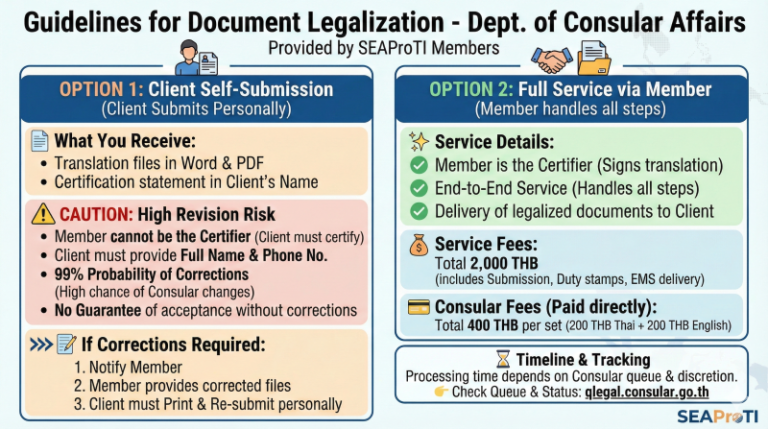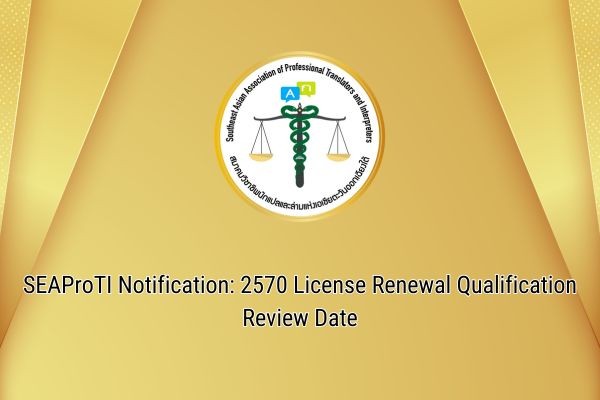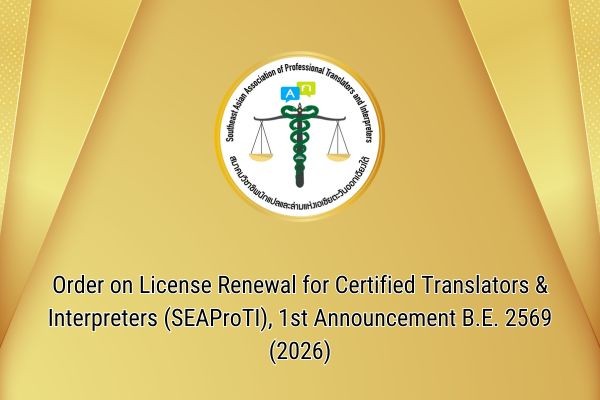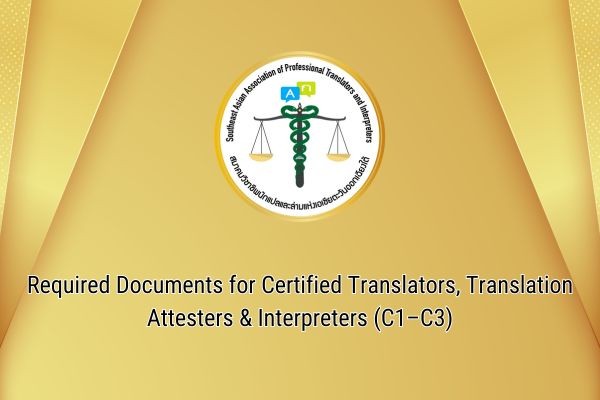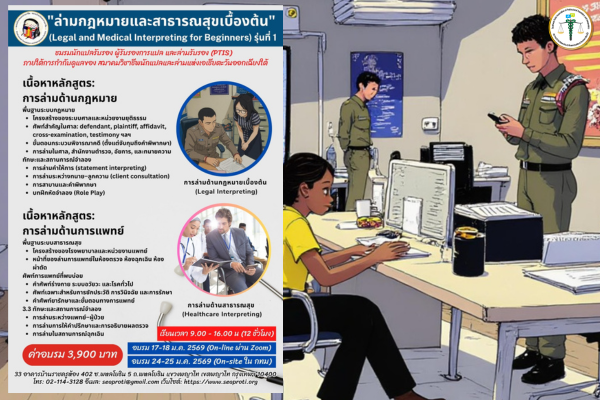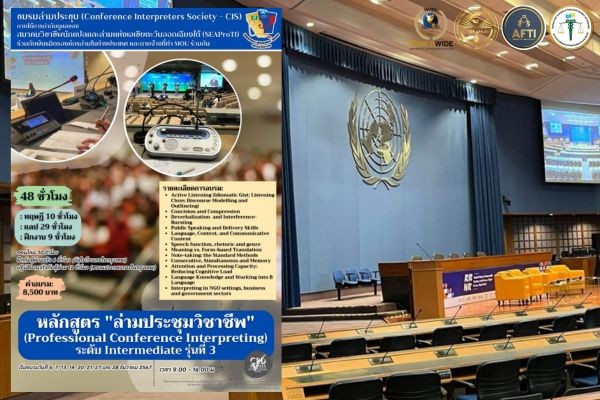Understanding Back Pain: Causes, Treatment, and Prevention
29 April 2025, Bangkok – Back pain is one of the most common health problems worldwide and a leading reason why people miss work or visit a doctor. It can range from a dull muscle ache to a sharp, shooting pain that radiates down the leg. While it often improves on its own with home care, persistent or severe back pain may indicate a more serious issue.
Common Symptoms and When to Seek Help
Back pain can manifest in different ways. Some people feel stiffness or aching in the lower back, while others experience sharp pain that worsens with certain movements such as bending, lifting, or walking. In some cases, the discomfort can spread down one or both legs, especially if a nerve is involved.
Although many cases resolve with rest and self-care, it’s important to see a healthcare provider if your pain lasts more than a few weeks, doesn’t improve with rest, or causes additional symptoms like numbness, tingling, weakness in the legs, or unexplained weight loss. Immediate medical attention is required if the pain is associated with fever, loss of bladder or bowel control, or follows a serious injury.
What Causes Back Pain?
Most back pain develops due to muscle strain or problems with spinal structures, although some cases have no clear cause. Heavy lifting, sudden awkward movements, or poor physical condition can strain muscles or ligaments. Spinal disks, which cushion the bones in your spine, can bulge or rupture, pressing on nearby nerves. Arthritis, especially osteoarthritis, may lead to spinal stenosis, a narrowing of the space around the spinal cord.
Other contributors include osteoporosis, which weakens the bones and can cause painful fractures, and ankylosing spondylitis, an inflammatory condition that leads to the fusion of spinal vertebrae.
Risk Factors
Several factors can increase your risk of back pain. Aging naturally wears down spinal structures, making pain more likely in people over 30 or 40. Lack of regular exercise weakens core muscles that support the spine, while carrying excess body weight places additional stress on the lower back. Conditions like depression, anxiety, and chronic stress can also influence how the body perceives pain.
Smoking is another significant risk factor. It reduces blood flow to the spine, increases the likelihood of disk problems, and contributes to osteoporosis. Improper lifting techniques, such as using the back instead of the legs, can also lead to injury.
Preventing Back Pain
Staying active is one of the best ways to prevent back problems. Regular low-impact aerobic exercises like walking, swimming, or cycling help build endurance and support spinal health. Strengthening your core muscles—particularly those in your abdomen and lower back—can protect your spine and prevent injuries.
Maintaining good posture throughout the day is essential. When standing, keep your spine aligned and avoid slouching. When sitting, use a chair with lumbar support and keep your feet flat on the floor. Avoid prolonged sitting, and take breaks to change position. When lifting, bend at the knees—not the waist—and hold objects close to your body.
If you smoke, quitting can reduce your risk of back pain and improve your overall spinal health.
Diagnosis and Tests
If your back pain requires medical attention, your doctor may perform a physical exam to assess movement, flexibility, and nerve function. You may be asked to describe your pain and how it affects your daily life.
To pinpoint the cause, imaging tests like X-rays, MRI, or CT scans may be used. X-rays can show bone problems like fractures or arthritis, while MRIs and CT scans provide detailed views of soft tissue, including disks and nerves. Blood tests can identify infections or inflammatory diseases. Nerve conduction studies, like electromyography (EMG), evaluate how well your nerves and muscles work together.
Treatment Options
For most people under age 60, back pain improves with non-invasive treatments. Over-the-counter medications like ibuprofen or naproxen can relieve inflammation and pain. If these aren’t effective, muscle relaxants or prescription anti-inflammatory drugs may be recommended. In certain cases, antidepressants have also been shown to relieve chronic pain.
Heat therapy, massage, and maintaining light activity can promote healing. Bed rest is not advised, as staying active supports recovery.
If the pain persists, physical therapy can help strengthen muscles, improve posture, and teach techniques to prevent future flare-ups. Some people benefit from cortisone injections, especially when pain radiates into the legs. Radiofrequency ablation, where targeted nerve endings are deactivated, may offer longer-term relief. In rare cases, surgical options may be considered for structural issues like herniated disks or spinal stenosis.
Alternative Treatments
Complementary therapies may provide additional relief for some patients. Acupuncture, chiropractic manipulation, and therapeutic massage have shown benefits in managing chronic back pain. Techniques such as yoga and stretching exercises can also improve flexibility and reduce stress, although patients should avoid movements that worsen symptoms.
Devices like transcutaneous electrical nerve stimulation (TENS) units, which deliver mild electrical pulses to block pain signals, have shown mixed results.
Preparing for a Medical Appointment
If your back pain persists, preparing for a doctor visit can improve the outcome. Write down your symptoms, when they started, and any lifestyle factors—such as stress or physical strain—that may contribute. Make a list of medications and supplements you take, and jot down questions to ask your provider. These may include:
- What is causing my back pain?
- Do I need any diagnostic tests?
- What are my treatment options?
- Are there side effects to the medications?
- How can I manage back pain with other health conditions?
- How long will recovery take?
- What steps can I take to avoid future back problems?
You may also want to bring a trusted friend or interpreter, especially if language is a barrier. Certified interpreters, such as those accredited by SEAProTI, can help ensure clear communication between patients and healthcare providers.
Final Thoughts
Back pain is a common yet complex condition that affects millions. With early intervention, healthy lifestyle choices, and the right treatment plan, most people can recover and return to their normal activities. If you’re experiencing back pain, don’t ignore it—taking timely steps can prevent it from becoming a long-term issue.
SEAProTI’s certified translators, translation certification providers, and certified interpreters:
The Southeast Asian Association of Professional Translators and Interpreters (SEAProTI) has officially announced the criteria and qualifications for individuals to register as “Certified Translators,” “Translation Certification Providers,” and “Certified Interpreters” under the association’s regulations. These guidelines are detailed in Sections 9 and 10 of the Royal Thai Government Gazette, issued by the Secretariat of the Cabinet under the Office of the Prime Minister of the Kingdom of Thailand, dated July 25, 2024, Volume 141, Part 66 Ng, Page 100.
To read the full publication, visit: the Royal Thai Government Gazette
เข้าใจอาการปวดหลัง: สาเหตุ การรักษา และการป้องกัน
29 เมษายน 2568, กรุงเทพมหานคร – อาการปวดหลัง เป็นหนึ่งในปัญหาสุขภาพที่พบบ่อยที่สุดทั่วโลก และเป็นสาเหตุสำคัญที่ทำให้หลายคนต้องลางานหรือไปพบแพทย์ อาการปวดหลังสามารถมีได้ตั้งแต่อาการตึงกล้ามเนื้อไปจนถึงอาการปวดแหลมๆ หรือปวดร้าวลงขา แม้อาการส่วนใหญ่มักดีขึ้นเองด้วยการดูแลที่บ้าน แต่หากอาการปวดรุนแรงหรือเรื้อรัง อาจบ่งชี้ถึงปัญหาสุขภาพที่ร้ายแรงขึ้นได้
อาการปวดหลัง และเมื่อใดควรพบแพทย์
อาการปวดหลังอาจเกิดขึ้นได้หลายรูปแบบ บางรายอาจรู้สึกตึงหรือปวดบริเวณหลังส่วนล่าง ขณะที่บางรายอาจมีอาการปวดแหลม หรือมีอาการแย่ลงเมื่อเคลื่อนไหว เช่น การก้ม ยกของ หรือเดิน และบางครั้งอาการอาจร้าวลงขาทั้งสองข้าง
โดยทั่วไป อาการปวดหลังสามารถดีขึ้นได้ภายในไม่กี่สัปดาห์ด้วยการพักผ่อนและดูแลตนเอง แต่ควรพบแพทย์หากอาการปวดไม่ทุเลาหลังจากหลายสัปดาห์ หรือหากมีอาการชาตามแขนขา อ่อนแรง น้ำหนักลดโดยไม่ทราบสาเหตุ หรือหากมีไข้ ร่วมกับปวดหลัง หรือควบคุมการขับถ่ายไม่ได้ ควรรีบพบแพทย์ทันที
สาเหตุของอาการปวดหลัง
อาการปวดหลังมักเกิดจากการบาดเจ็บของกล้ามเนื้อหรือเส้นเอ็นที่รองรับกระดูกสันหลัง เช่น การยกของหนักผิดท่า หรือการเคลื่อนไหวกะทันหัน นอกจากนี้ยังอาจเกิดจากหมอนรองกระดูกสันหลังที่เคลื่อนหรือแตก จนกดทับเส้นประสาท หรือโรคข้อเสื่อมที่ทำให้โพรงกระดูกสันหลังแคบลง (spinal stenosis)
สาเหตุอื่นๆ ได้แก่ โรคกระดูกพรุน (osteoporosis) ซึ่งทำให้กระดูกเปราะและหักได้ง่าย หรือโรคข้อยึดติดกระดูกสันหลัง (ankylosing spondylitis) ซึ่งเป็นการอักเสบเรื้อรังที่ทำให้กระดูกสันหลังบางส่วนเชื่อมติดกัน
ปัจจัยเสี่ยง
หลายปัจจัยสามารถเพิ่มโอกาสเกิดอาการปวดหลังได้ เช่น
- อายุ: เริ่มพบได้บ่อยตั้งแต่อายุ 30-40 ปีขึ้นไป
- การขาดการออกกำลังกาย: ทำให้กล้ามเนื้อแกนกลางอ่อนแอ
- น้ำหนักตัวเกิน: เพิ่มแรงกดต่อกระดูกสันหลัง
- โรคประจำตัว: เช่น มะเร็ง หรือข้อเสื่อม
- ภาวะทางจิตใจ: เช่น ภาวะซึมเศร้าหรือวิตกกังวล
- การสูบบุหรี่: ทำให้เลือดไหลเวียนไปหล่อเลี้ยงกระดูกสันหลังน้อยลง และเพิ่มความเสี่ยงของหมอนรองกระดูกเสื่อม
นอกจากนี้ การยกของผิดวิธีโดยใช้หลังแทนการใช้ขา ก็เป็นปัจจัยเสี่ยงที่สำคัญเช่นกัน
การป้องกันอาการปวดหลัง
การป้องกันที่ดีที่สุดคือการดูแลร่างกายให้แข็งแรงและใช้งานหลังอย่างถูกต้อง การออกกำลังกายแบบแอโรบิกเบาๆ เช่น เดิน ว่ายน้ำ หรือขี่จักรยาน ช่วยเสริมความแข็งแรงให้กับกล้ามเนื้อหลังและหน้าท้องได้ การฝึกกล้ามเนื้อแกนกลาง (core muscles) จะช่วยป้องกันการบาดเจ็บ
การรักษาท่าทางที่ดีในชีวิตประจำวันก็สำคัญ เช่น การยืนให้หลังตรง ไม่งอ หรือการนั่งโดยใช้เก้าอี้ที่รองรับหลังส่วนล่างได้ดี รวมทั้งการยกของอย่างถูกวิธี โดยงอเข่าแทนการก้มหลัง และกอดวัตถุไว้ใกล้ตัว
การเลิกสูบบุหรี่ยังช่วยลดความเสี่ยงของอาการปวดหลังได้อย่างมีนัยสำคัญ
การวินิจฉัยและการตรวจเพิ่มเติม
หากจำเป็นต้องพบแพทย์ แพทย์จะตรวจร่างกายประเมินการเคลื่อนไหว ความแข็งแรงของกล้ามเนื้อ และการทำงานของเส้นประสาท นอกจากนี้ อาจมีการสั่งตรวจเพิ่มเติม เช่น
- เอกซเรย์: ตรวจหากระดูกหักหรือข้อเสื่อม
- MRI หรือ CT Scan: ตรวจหมอนรองกระดูก เส้นประสาท และเนื้อเยื่อรอบๆ
- การตรวจเลือด: ตรวจการติดเชื้อหรือโรคอักเสบ
- การตรวจเส้นประสาท (EMG): ประเมินการทำงานของเส้นประสาทและกล้ามเนื้อ
วิธีการรักษาอาการปวดหลัง
สำหรับผู้ป่วยส่วนใหญ่ โดยเฉพาะคนอายุต่ำกว่า 60 ปี อาการปวดหลังสามารถดีขึ้นได้ด้วยการรักษาแบบไม่รุกล้ำ เช่น การใช้ยาแก้ปวดทั่วไป เช่น ไอบูโพรเฟน หรือยาแก้อักเสบกลุ่ม NSAIDs ร่วมกับการประคบร้อน และการเคลื่อนไหวเบาๆ เช่น การเดินช้าๆ
หากอาการไม่ดีขึ้น อาจพิจารณาใช้ยาคลายกล้ามเนื้อ ยาต้านซึมเศร้าบางชนิด หรือทำกายภาพบำบัดเพื่อเสริมสร้างกล้ามเนื้อและปรับท่าทางให้ถูกต้อง ในบางกรณี อาจต้องพิจารณาการฉีดยาสเตียรอยด์ หรือการรักษาด้วยการจี้เส้นประสาทด้วยคลื่นวิทยุ (radiofrequency ablation) และหากมีภาวะกดทับเส้นประสาทรุนแรง อาจต้องพิจารณาการผ่าตัด
ทางเลือกเสริมในการรักษา
การแพทย์ทางเลือก เช่น การฝังเข็ม การจัดกระดูก (chiropractic care) การนวด และการใช้เครื่องกระตุ้นไฟฟ้าแบบผ่านผิวหนัง (TENS) อาจช่วยบรรเทาอาการปวดได้ในบางราย นอกจากนี้ โยคะยังช่วยเพิ่มความยืดหยุ่น และลดความเครียด แต่ควรหลีกเลี่ยงท่าที่ทำให้อาการแย่ลง
เตรียมตัวก่อนพบแพทย์
ก่อนพบแพทย์ ควรจดบันทึกอาการที่พบ ระยะเวลา และปัจจัยที่อาจเกี่ยวข้อง เช่น ความเครียดหรือการออกแรงหนัก รวมถึงรายชื่อยาและอาหารเสริมที่ใช้อยู่
คำถามที่ควรเตรียมไว้สอบถามแพทย์ ได้แก่:
- สาเหตุที่เป็นไปได้ของอาการปวดหลังคืออะไร?
- จำเป็นต้องตรวจเพิ่มเติมหรือไม่?
- แนวทางการรักษาที่เหมาะสมคืออะไร?
- ยาที่แนะนำมีผลข้างเคียงหรือไม่?
- ควรดูแลตัวเองอย่างไรในระหว่างรักษา?
- วิธีป้องกันไม่ให้ปวดหลังซ้ำมีอะไรบ้าง?
การพาผู้ช่วย เช่น ล่ามที่มีใบรับรอง SEAProTI ไปด้วย อาจช่วยให้การสื่อสารกับแพทย์ชัดเจนยิ่งขึ้น โดยเฉพาะในกรณีที่มีอุปสรรคด้านภาษา
สรุป
อาการปวดหลังเป็นปัญหาสุขภาพที่พบบ่อยแต่สามารถป้องกันและรักษาได้ หากได้รับการดูแลอย่างเหมาะสมตั้งแต่เนิ่นๆ การรักษาร่างกายให้แข็งแรง ใช้ท่าทางที่ถูกต้อง และปรึกษาแพทย์เมื่อมีอาการผิดปกติ จะช่วยให้ฟื้นตัวได้เร็วและลดโอกาสเกิดอาการเรื้อรังในระยะยาว
เกี่ยวกับนักแปลรับรอง ผู้รับรองการแปล และล่ามรับรองของสมาคมวิชาชีพนักแปลและล่ามแห่งเอเชียตะวันออกเฉียงใต้
สมาคมวิชาชีพนักแปลและล่ามแห่งเอเชียตะวันออกเฉียงใต้ (SEAProTI) ได้ประกาศหลักเกณฑ์และคุณสมบัติผู้ที่ขึ้นทะเบียนเป็น “นักแปลรับรอง (Certified Translators) และผู้รับรองการแปล (Translation Certification Providers) และล่ามรับรอง (Certified Interpreters)” ของสมาคม หมวดที่ 9 และหมวดที่ 10 ในราชกิจจานุเบกษา ของสำนักเลขาธิการคณะรัฐมนตรี ในสำนักนายกรัฐมนตรี แห่งราชอาณาจักรไทย ลงวันที่ 25 ก.ค. 2567 เล่มที่ 141 ตอนที่ 66 ง หน้า 100 อ่านฉบับเต็มได้ที่: นักแปลรับรอง ผู้รับรองการแปล และล่ามรับรอง

